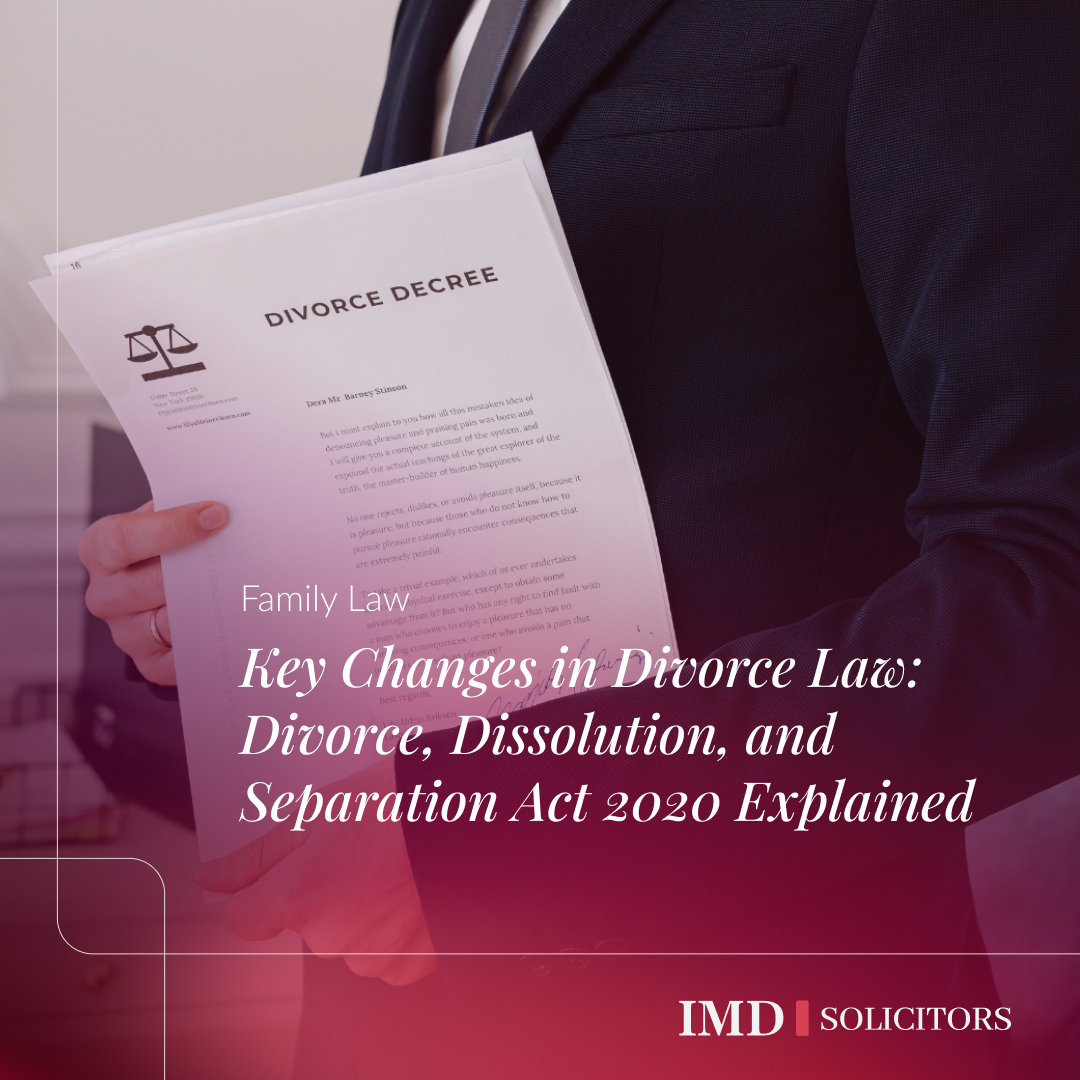Key Changes in Divorce Law: Divorce, Dissolution, and Separation Act 2020 Explained

Speak to a member of our specialist international team of UK family lawyers today on 0330 107 0107.
The Divorce, Dissolution, and Separation Act 2020 brought about significant changes in the divorce process in England and Wales, with these reforms coming into effect in April 2022. The alterations aimed to simplify the divorce procedure, remove unnecessary conflict, and make the process more accessible for couples, particularly those who wish to separate amicably. This case study will explain the key changes introduced by the Act, including the elimination of fault-based divorce applications, the possibility of joint applications, and the new terminology adopted by the courts.
Introduction to the Case
The Divorce, Dissolution, and Separation Act 2020 significantly changed divorce law in England and Wales. Before this legislation, divorce applications were based on fault-related grounds, which often heightened tensions between the parties. Applicants had to provide a reason for seeking a divorce, which could include adultery, unreasonable behaviour, or separation for a specific duration (two or five years). The new law significantly reduces the emotional and legal strain on divorcing couples, facilitating a much smoother and less contentious process.
Key Changes in Divorce Law
1. Removal of Fault-Based Divorce Applications
One of the most significant changes in divorce law under the new legislation is the removal of the requirement for applicants to prove fault or give a reason for the divorce. Previously, individuals had to explain why the marriage had broken down, providing one of the recognised grounds such as adultery or unreasonable behaviour. These grounds often led to conflict between the parties, particularly when one spouse was blamed for the breakdown of the relationship.
Under the new regime, there is only one ground for divorce: the irretrievable breakdown of the marriage. This removes the need for a party to justify their decision to divorce, streamlining the process and reducing the emotional burden on the applicants. The focus now shifts entirely to the fact that the marriage has ended, making the proceedings less adversarial.
2. The Introduction of Joint Applications
Another key change brought by the Divorce, Dissolution, and Separation Act 2020 is the introduction of joint divorce applications. Under the previous system, one party had to initiate the divorce process, which often placed them in an adversarial position against the other. With the new legislation, both spouses can apply for divorce together, making the process more collaborative. This is particularly beneficial for couples who have reached an amicable decision to separate and wish to minimise conflict during the divorce process.
The option for joint applications allows both parties to be recognised as applicants, ensuring equal involvement in the proceedings. This change provides an opportunity for couples to resolve their differences in a more cooperative manner, which can be particularly important when children or financial matters are involved.
3. Streamlined Process and Reduced Conflict
The removal of blame from divorce proceedings reduces the potential for conflict, which previously could have resulted from accusations of adultery or unreasonable behaviour. The absence of fault-based grounds means that the focus is no longer on who is to blame for the breakdown of the marriage but on the shared recognition that the relationship has irretrievably ended.
This shift in approach is particularly helpful for couples who may already be in an emotionally vulnerable state and want to move forward with their lives without additional strain. By making the divorce process less combative, the new system supports parties in reaching a resolution without the need for prolonged disputes or antagonism.
4. Changes in Divorce Orders
Alongside changes to the divorce process itself, the terminology used in divorce orders has also been updated. Under the previous system, divorce orders were referred to as “decree nisi” and “decree absolute.” These terms have now been replaced with “conditional order” and “final order of divorce,” respectively.
The conditional order now replaces the decree nisi and signifies that the court has agreed that the divorce should proceed. It is the first stage in the process of legally ending the marriage. The final order of divorce is the equivalent of the decree absolute and marks the official dissolution of the marriage. These new terms align the legal process with a more neutral approach, reflecting the non-fault basis of the proceedings.
5. Single Solicitor Services for Amicable Divorces
Another significant change in the legal market is the availability of single solicitor services for amicable divorces. In the past, each party in a divorce was usually required to have separate legal representation.
This service is particularly beneficial for couples who are focused on reaching a fair and balanced settlement without resorting to adversarial litigation. By using a single solicitor, both parties can save on legal costs, expedite the divorce process, and foster a more cooperative relationship post-divorce, which is especially important if there are children involved.
Practical Insights and Legal Considerations
The changes introduced by the Divorce, Dissolution, and Separation Act 2020 reflect a more modern approach to family law, emphasising simplicity and cooperation over conflict and blame. While these reforms have undoubtedly made the divorce process more straightforward, it is important to note that not all divorces are amicable, and there will still be cases where disputes arise, particularly in relation to financial settlements or child custody arrangements.
For clients seeking a divorce, it is essential to seek expert legal advice to understand their rights and obligations. Even under the new framework, issues such as asset division, spousal support, and child arrangements can still be contentious. It is also important to understand that while the divorce process itself may be simpler, the financial and emotional complexities of dissolving a marriage remain.
Conclusion
For clients seeking a divorce, it is essential to seek expert legal advice to understand their rights and obligations. Even under the new framework, issues such as asset division, spousal support, and child arrangements can still be contentious. It is also important to understand that while the divorce process itself may be simpler, the financial and emotional complexities of dissolving a marriage remain. At IMD Solicitors LLP, we provide full support to clients through the new divorce laws, whether seeking a collaborative divorce or assistance with disputed matters.
This article is for general information only and does not constitute legal or professional advice. Please note that the law may have changed since this article was published.



















